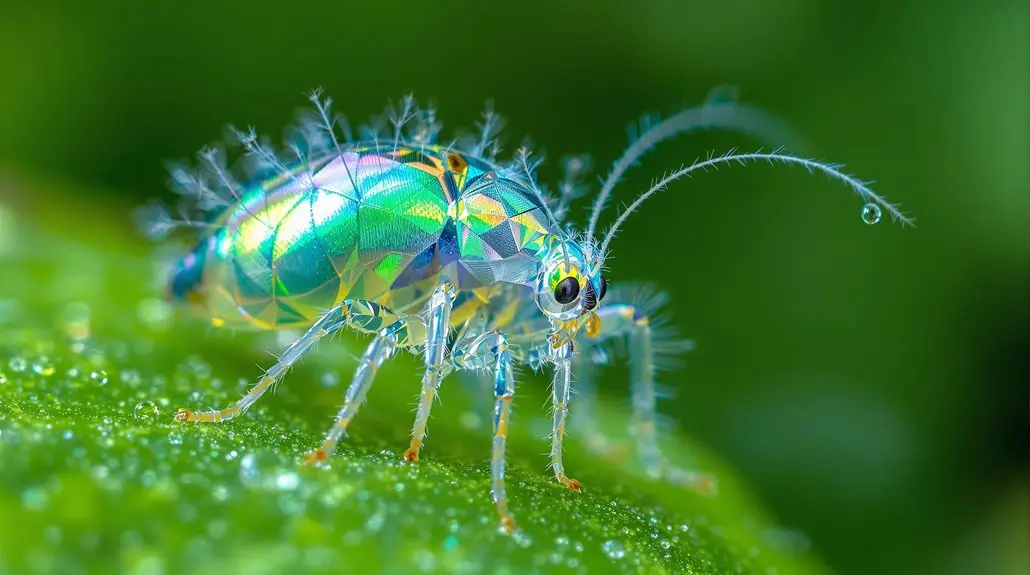Phalacrococcus howertoni, a recently identified exotic soft scale insect in Florida, exhibits a complex life cycle with adult females producing high numbers of offspring over their approximately 60-day lifespan. This polyphagous pest negatively impacts various host plants, causing distress through leaf twisting and wilting while producing honeydew that fosters sooty mold growth. Effective management strategies involve understanding its biology, evaluating natural enemies, and applying integrated pest management approaches. Explore further to uncover additional insights into its ecological significance.
Key Insights
- Phalacrococcus howertoni females have a lifespan of 60-61 days, producing approximately 382-395 instars during their reproductive period.
- Males of the species live less than one day and undergo four immature stages before reaching adulthood.
- Infestations cause significant damage to host plants, including wilting leaves and sooty mold growth, affecting plant health and vigor.
- The species is polyphagous, threatening economically important crops like mango and guava across various regions in Florida and the Caribbean.
- Effective management involves biological controls, selective pesticide application, and monitoring pest distribution to maintain ecological balance.
Identification and Distribution
When examining *Phalacrococcus howertoni*, you’ll find it classified as a new genus and species within the family Coccidae, as established by researchers Hodges and Hodgson in 2010. This insect exhibits distinctive physical characteristics; adult females are bright green, oval-shaped, and can exceed 4 mm by 2 mm in size, particularly lacking the ovisacs typical of *Philephedra tuberculosa*. You might confuse it with *Philephedra* species due to some similarities, yet the absence of white waxy ovisacs serves as a key diagnostic feature. First detected in Monroe County, Florida, in 2008, its distribution has expanded across 21 counties in Florida and has been reported in various Caribbean regions, illustrating its global spread and potential ecological impact. This scale insect has a known host plant range that includes 72 species across 34 families, highlighting its adaptability and threat to diverse plant life.
Biology and Life Cycle
| Life Stage | Duration | Fecundity |
|---|---|---|
| Female Lifespan | 60.3-61.5 days | 382.4-394.7 instars |
| Male Lifespan | < 1 day | N/A |
| Pre-Oviposition | 17.6-19.1 days | N/A |
| Oviposition Period | 13.9-15.5 days | N/A |
Females of the exotic soft scale insect Phalacrococcus howertoni undergo three immature stages before reaching adulthood.
Immature Stages
The immature stages of Phalacrococcus howertoni play an essential role in its life cycle, as they undergo significant development that directly influences the species’ survival and reproductive success. These stages include both male and female nymphs, each with distinct characteristics and durations.
- The first instar lasts approximately 12.4 to 12.6 days, with a survival rate of around 50%.
- Females progress through three instars, totaling 30.8 to 31.1 days before adulthood.
- Males, on the other hand, experience four instars, completing their development in 29.0 to 29.7 days. Increased ant presence can indicate potential scale insect infestation, which further highlights the importance of monitoring these immature stages.
- Environmental conditions, such as temperature and humidity, remain consistent across development stages, supporting growth regardless of host plant type.
Impact on Host Plants
Significant damage occurs to host plants infested by Phalacrococcus howertoni, as these pests disrupt normal growth processes and overall plant health. Symptoms of infestation include twisting and wilting leaves, premature leaf drop, and the growth of sooty mold, which develops from the copious honeydew produced by females. This honeydew inhibits photosynthesis, further compromising plant vigor. High infestations can lead to tip dieback, declining health, and even death of smaller or severely affected plants. The polyphagous nature of P. howertoni allows it to threaten a wide range of economically important crops, such as mango and guava, posing risks to agriculture and ornamental landscapes. Therefore, understanding the impact of this pest on host plants is essential for effective management strategies.
Natural Enemies and Management
- Utilize biological controls by introducing natural predators.
- Apply systemic and contact pesticides selectively to target infestations.
- Practice proper plant care and quarantine measures to limit spread.
- Engage regulatory bodies to guarantee compliance with pesticide regulations.
- Monitoring species distribution is crucial to understanding the spread of P. howertoni and implementing effective management strategies. Additionally, using eco-friendly products can minimize environmental impact while managing pests effectively.
Through these methods, you can effectively manage P. howertoni while maintaining the health of your plants and the surrounding ecosystem.
Environmental and Economic Implications
As you explore the environmental and economic implications of Phalacrococcus howertoni, you’ll notice its detrimental impact on plant diversity, which can lead to significant declines in various ecosystems. The extensive damage caused by infestations not only affects the health of individual plants but also results in substantial economic losses for industries reliant on ornamental and agricultural production. Understanding these consequences is essential for developing effective management strategies that mitigate both ecological disruption and financial strain. Additionally, the holistic approach to pest control emphasizes the importance of sustainable practices in managing such infestations effectively.
Plant Diversity Decline
While the decline in plant diversity presents numerous environmental and economic challenges, understanding its causes and implications is essential for effective mitigation. Several factors contribute to this decline, including land use changes, monoculture practices, and human population growth, all of which lead to habitat loss and reduced plant species. The effects on ecosystems are profound, as diminished plant diversity compromises nutrient cycling, disrupts pollination services, and decreases ecosystem resilience. Consequently, fragile ecosystems become increasingly vulnerable to invasive species, further exacerbating biodiversity loss. Additionally, the use of glyphosate and fertilizers significantly impacts nutrient-poor plants, further contributing to the decline of plant diversity.
- Land use changes drive biodiversity loss.
- Monoculture practices eliminate native species.
- Pesticide use impacts nutrient-poor plants.
- Human population growth demands more agricultural land.
Economic Losses Overview
The decline in plant diversity not only poses ecological challenges but also has significant economic implications, particularly when invasive species, such as Phalacrococcus howertoni, enter the equation. This scale insect threatens at least 35 plant families, including economically important fruit trees like avocados and mangos, as well as ornamental plants such as croton. Large populations can lead to premature leaf loss and dieback, reducing crop yields and overall plant quality. Additionally, the honeydew secreted by P. howertoni fosters sooty mold growth, which inhibits photosynthesis. The potential economic losses could escalate, particularly in the horticultural industry, as management costs rise to control this pest, further burdening affected sectors and complicating international trade regulations concerning plant exports.
Future Research Directions
Future research directions regarding Phalacrococcus howertoni should prioritize understanding its biology, ecological interactions, and effective management strategies, particularly given the insect’s economic and environmental significance. Researchers can focus on a few key areas to gain deeper insights and develop solutions.
- Investigate the reproductive strategies and population dynamics to anticipate growth rates. Understanding the high reproductive rate of P. howertoni will be crucial in predicting population booms and implementing timely management strategies.
- Explore the polyphagous nature and host plant interactions to identify vulnerable species.
- Assess the effectiveness of natural predators and develop biocontrol methods.
- Create and evaluate integrated pest management (IPM) strategies that combine biological and chemical control measures.
These research efforts will not only help mitigate the economic threats posed by this scale insect but also contribute to understanding its broader ecological impacts.
Final Thoughts
The Hidden Impact of Phalacrococcus Howertoni in South Florida
To conclude, the life history of Phalacrococcus howertoni reveals a complex interplay between this exotic soft scale insect and its environment in Florida. Researchers have meticulously documented its identification, biology, and impact on host plants, illustrating the delicate balance of ecosystems. As these tiny organisms cling to their hosts, they serve as a reminder of the intricate web of life, highlighting the importance of continued research to manage their effects and protect native flora against potential threats.
Join the Fight Against Invasive Pests!
At NaturePest Holistic Pest Control, we are dedicated to safeguarding South Florida‘s natural beauty. Stay informed and proactive in the battle against invasive species like Phalacrococcus howertoni. Together, we can protect our environment and ensure a thriving ecosystem for future generations.



